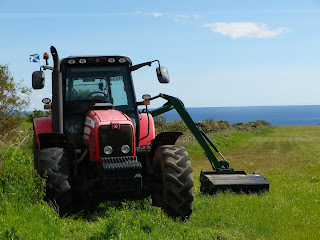 Wednesday 17th June
Wednesday 17th JuneLagg to Kildonnan
Walk distance 8.5km
Cycle 0km
Height 0 m
6 hours - 3 hours waiting for tide to drop
Total coastal distance on Arran walked 38.5km
Running height climbed 1359 m
Total coastal distance cycled 0
Total coastal distance driven 0
 |
| Failing to beat the self timer on my camera |
Parked at Whiting Bay, which was where I was hoping to walk to by the end of the day. Caught a bus to Lagg Hotel and walked the first section to find the ancient barrow of Torrylin Cairn, a Neolithic chambered tomb, used for communal burials.
Weather wise it was a little windy and it looked as if rain threatened. But the wind was behind me and at one point it did rain hard. The first section of the walk is along really nice beaches and super views of Ailsa Craig island. A stray cloud made it look as if the island was erupting. 65 million years or so after it last did so.

Early on I saw one seal but otherwise it seemed quiet. I reached the large boulder that marks where the Black Cave. It was easy to get into the cave and explore it. It is Arrans largest cave. I presumed some rock pipits had a nest nearby as they kept calling in alarm and flying around the cave entrance.
Adjacent to the cave is a fine waterfall plummeting over the old cliffs. The tide was nearly at its height so it wasn’t possible to walk around Bennan Head. I decided to have lunch and wait. I found a large rock that sheltered me from the wind. As I waited I could see gannets occasionally fly close by. These might nest on Ailsa Craig - an island renowned for its breeding gannet colony. Every now and then I checked the tide but it took a long time to turn and drop. I waited for close on three hours, but enjoyed it thoroughly, just soaking up the atmosphere and peace. In fact once it was safe to do so without getting wet feet I realised I could have climbed around the headland quite safely. The bigger challenge was the boulder field beyond. These boulders were of all sizes and at many angles. Thankfully they weren’t slippery if you avoided the ones below the tide line. In places there were small boulders and pebbles but these tended to move around and weren’t so stable. Another peregrine announced its presence and called constantly as I walked below its cliff, and presumably nest. Once beyond this a gentle machair grassland fringed beaches. The beaches have scattered boulders and pebble areas. Also large igneous basalt dykes project into the water. Some of these look artificial, just like groynes built into the breakers. A few did have boulders added to them to act a stock barriers. In places seals rested on these dykes and a few perched seemingly precariously on rocks in the water.


The island of Plada, with a round lighthouse was now clearly visible. Cattle grazed the machair. The village store marked on the OS map doesn’t exist anymore. At the Kildonan Hotel by an old telephone exchange building I decided to head back, as it was already well into the evening. The next section to Whiting Bay is apparently very slow going as its all boulders.












































